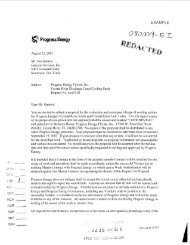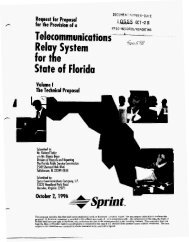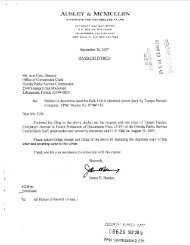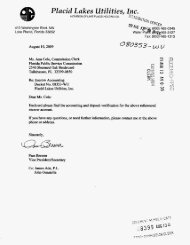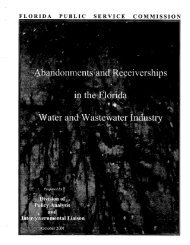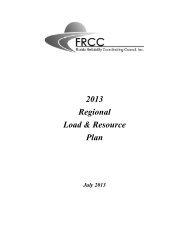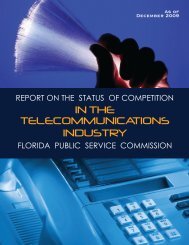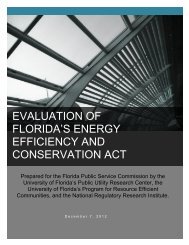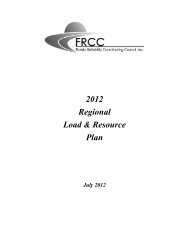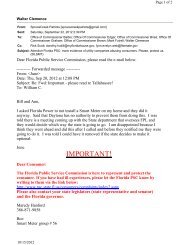Review of 2008 Ten-Year Site Plans - Public Service Commission
Review of 2008 Ten-Year Site Plans - Public Service Commission
Review of 2008 Ten-Year Site Plans - Public Service Commission
Create successful ePaper yourself
Turn your PDF publications into a flip-book with our unique Google optimized e-Paper software.
Demand-Side Management and Energy Efficiency<br />
As previously discussed, load and energy projections are affected by many variables.<br />
Consumer choice and lifestyle, however, serve as the foundation to controlling load and energy<br />
demand. Florida’s utilities play an important role in educating consumers to make wise energy<br />
decisions.<br />
As illustrated in Figure 4 below, statewide per capita residential energy consumption usage<br />
has increased over the past 15 years but decreased over the past 5 years. Given current population<br />
growth projections, residential customers would need to reduce their per capita energy consumption<br />
by more than 15 percent over the planning period in order to maintain or reduce their total energy<br />
consumption.<br />
Per Customer Usage (KWh/<strong>Year</strong>)<br />
Figure 4. State <strong>of</strong> Florida: Energy Consumption per Residential Customer<br />
17,000<br />
16,000<br />
15,000<br />
14,000<br />
13,000<br />
12,000<br />
1991 1995 1999 2003 2007 2011 2015 2019<br />
Actual Jan 06' Forecast Jan 07' Forecast Jan 08' Forecast<br />
Key to the reduction <strong>of</strong> energy usage is customer participation in utility sponsored demandside<br />
management (DSM) and energy conservation programs. Since 1980, utilities have <strong>of</strong>fered DSM<br />
programs to customers based on the requirements <strong>of</strong> the Florida Energy Efficiency and Conservation<br />
Act (FEECA). The FEECA emphasizes reducing the growth rates <strong>of</strong> weather-sensitive peak demand,<br />
reducing and controlling the growth rates <strong>of</strong> electricity consumption, and reducing the consumption <strong>of</strong><br />
scarce resources such as petroleum fuels. To accomplish these objectives, the FEECA requires the<br />
<strong>Commission</strong> to establish conservation and DSM goals and requires all IOUs and any municipal or<br />
cooperative utility with annual energy sales <strong>of</strong> at least 2,000 GWh as <strong>of</strong> July 1, 1993, to implement<br />
DSM programs to meet the established goals. Demand and energy goals for the seven FEECA<br />
utilities (FPL, FPUC, 5 GULF, JEA, OUC, PEF, and TECO) were last set in July 2004. The goals set<br />
5 Florida <strong>Public</strong> Utilities Corporation (FPUC) is a non-generating, investor-owned utility subject to FEECA’s requirements.<br />
FPUC does not file a <strong>Ten</strong>-<strong>Year</strong> <strong>Site</strong> Plan with the PSC.<br />
<strong>Review</strong> <strong>of</strong> <strong>2008</strong> <strong>Ten</strong>-<strong>Year</strong> <strong>Site</strong> <strong>Plans</strong> - 11 -




